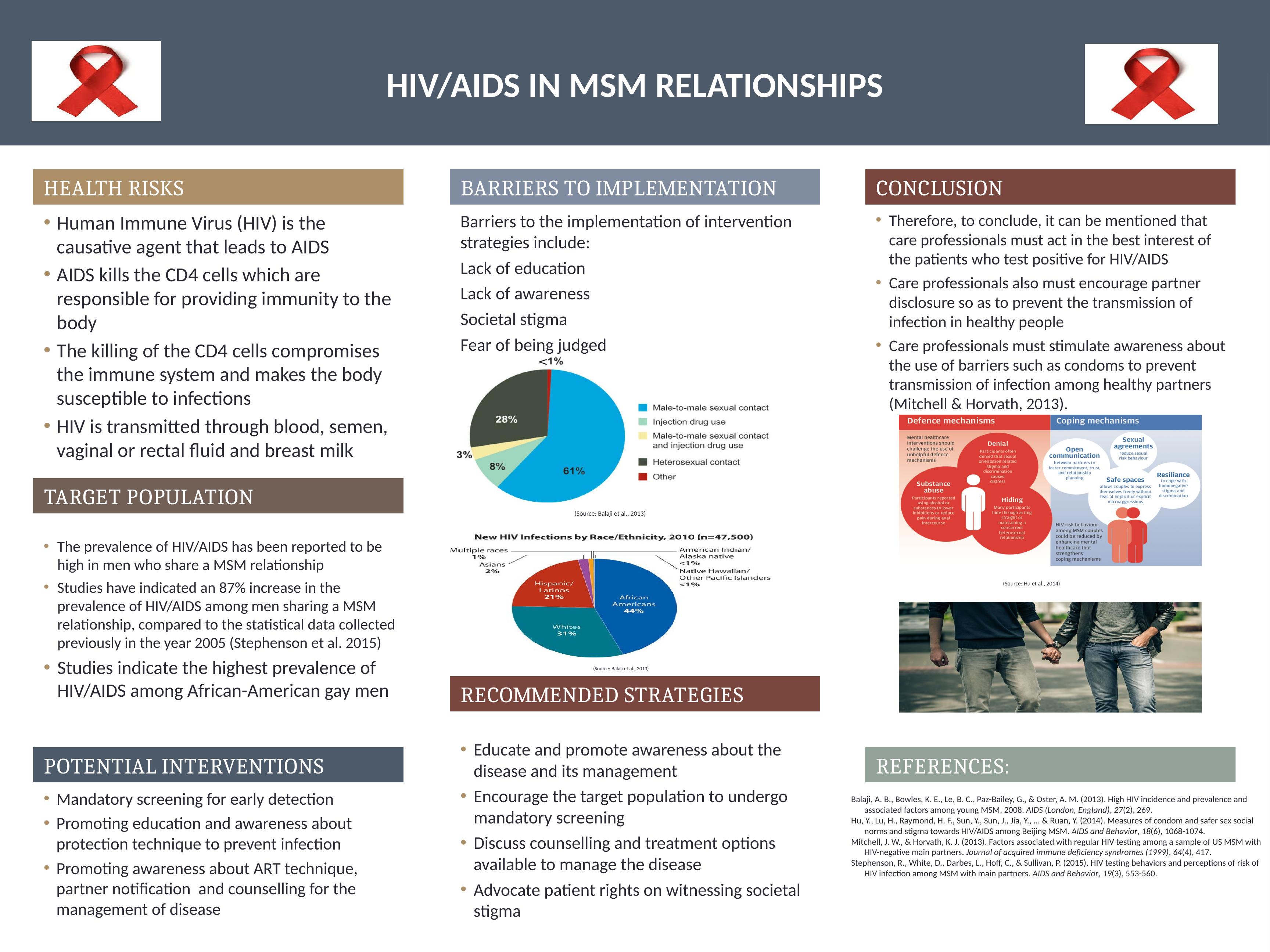HIV/AIDS in MSM Relationships: Health Risks, Barriers to Implementation, and Recommended Strategies
Added on 2023-04-21
1 Pages565 Words67 Views
HIV/AIDS IN MSM RELATIONSHIPS
HEALTH RISKS
• Human Immune Virus (HIV) is the
causative agent that leads to AIDS
• AIDS kills the CD4 cells which are
responsible for providing immunity to the
body
• The killing of the CD4 cells compromises
the immune system and makes the body
susceptible to infections
• HIV is transmitted through blood, semen,
vaginal or rectal fluid and breast milk
TARGET POPULATION
• The prevalence of HIV/AIDS has been reported to be
high in men who share a MSM relationship
• Studies have indicated an 87% increase in the
prevalence of HIV/AIDS among men sharing a MSM
relationship, compared to the statistical data collected
previously in the year 2005 (Stephenson et al. 2015)
• Studies indicate the highest prevalence of
HIV/AIDS among African-American gay men
POTENTIAL INTERVENTIONS
• Mandatory screening for early detection
• Promoting education and awareness about
protection technique to prevent infection
• Promoting awareness about ART technique,
partner notification and counselling for the
management of disease
BARRIERS TO IMPLEMENTATION
Barriers to the implementation of intervention
strategies include:
Lack of education
Lack of awareness
Societal stigma
Fear of being judged
RECOMMENDED STRATEGIES
• Educate and promote awareness about the
disease and its management
• Encourage the target population to undergo
mandatory screening
• Discuss counselling and treatment options
available to manage the disease
• Advocate patient rights on witnessing societal
stigma
REFERENCES:
CONCLUSION
• Therefore, to conclude, it can be mentioned that
care professionals must act in the best interest of
the patients who test positive for HIV/AIDS
• Care professionals also must encourage partner
disclosure so as to prevent the transmission of
infection in healthy people
• Care professionals must stimulate awareness about
the use of barriers such as condoms to prevent
transmission of infection among healthy partners
(Mitchell & Horvath, 2013).
Balaji, A. B., Bowles, K. E., Le, B. C., Paz-Bailey, G., & Oster, A. M. (2013). High HIV incidence and prevalence and
associated factors among young MSM, 2008. AIDS (London, England), 27(2), 269.
Hu, Y., Lu, H., Raymond, H. F., Sun, Y., Sun, J., Jia, Y., ... & Ruan, Y. (2014). Measures of condom and safer sex social
norms and stigma towards HIV/AIDS among Beijing MSM. AIDS and Behavior, 18(6), 1068-1074.
Mitchell, J. W., & Horvath, K. J. (2013). Factors associated with regular HIV testing among a sample of US MSM with
HIV-negative main partners. Journal of acquired immune deficiency syndromes (1999), 64(4), 417.
Stephenson, R., White, D., Darbes, L., Hoff, C., & Sullivan, P. (2015). HIV testing behaviors and perceptions of risk of
HIV infection among MSM with main partners. AIDS and Behavior, 19(3), 553-560.
(Source: Balaji et al., 2013)
(Source: Balaji et al., 2013)
(Source: Hu et al., 2014)
HEALTH RISKS
• Human Immune Virus (HIV) is the
causative agent that leads to AIDS
• AIDS kills the CD4 cells which are
responsible for providing immunity to the
body
• The killing of the CD4 cells compromises
the immune system and makes the body
susceptible to infections
• HIV is transmitted through blood, semen,
vaginal or rectal fluid and breast milk
TARGET POPULATION
• The prevalence of HIV/AIDS has been reported to be
high in men who share a MSM relationship
• Studies have indicated an 87% increase in the
prevalence of HIV/AIDS among men sharing a MSM
relationship, compared to the statistical data collected
previously in the year 2005 (Stephenson et al. 2015)
• Studies indicate the highest prevalence of
HIV/AIDS among African-American gay men
POTENTIAL INTERVENTIONS
• Mandatory screening for early detection
• Promoting education and awareness about
protection technique to prevent infection
• Promoting awareness about ART technique,
partner notification and counselling for the
management of disease
BARRIERS TO IMPLEMENTATION
Barriers to the implementation of intervention
strategies include:
Lack of education
Lack of awareness
Societal stigma
Fear of being judged
RECOMMENDED STRATEGIES
• Educate and promote awareness about the
disease and its management
• Encourage the target population to undergo
mandatory screening
• Discuss counselling and treatment options
available to manage the disease
• Advocate patient rights on witnessing societal
stigma
REFERENCES:
CONCLUSION
• Therefore, to conclude, it can be mentioned that
care professionals must act in the best interest of
the patients who test positive for HIV/AIDS
• Care professionals also must encourage partner
disclosure so as to prevent the transmission of
infection in healthy people
• Care professionals must stimulate awareness about
the use of barriers such as condoms to prevent
transmission of infection among healthy partners
(Mitchell & Horvath, 2013).
Balaji, A. B., Bowles, K. E., Le, B. C., Paz-Bailey, G., & Oster, A. M. (2013). High HIV incidence and prevalence and
associated factors among young MSM, 2008. AIDS (London, England), 27(2), 269.
Hu, Y., Lu, H., Raymond, H. F., Sun, Y., Sun, J., Jia, Y., ... & Ruan, Y. (2014). Measures of condom and safer sex social
norms and stigma towards HIV/AIDS among Beijing MSM. AIDS and Behavior, 18(6), 1068-1074.
Mitchell, J. W., & Horvath, K. J. (2013). Factors associated with regular HIV testing among a sample of US MSM with
HIV-negative main partners. Journal of acquired immune deficiency syndromes (1999), 64(4), 417.
Stephenson, R., White, D., Darbes, L., Hoff, C., & Sullivan, P. (2015). HIV testing behaviors and perceptions of risk of
HIV infection among MSM with main partners. AIDS and Behavior, 19(3), 553-560.
(Source: Balaji et al., 2013)
(Source: Balaji et al., 2013)
(Source: Hu et al., 2014)

End of preview
Want to access all the pages? Upload your documents or become a member.
Related Documents
STIs within Bisexual Communitylg...
|1
|603
|344
HIV/AIDS in United States Issue 2022lg...
|4
|674
|21
Creating Awareness about HIV/AIDS: A Community Level Approachlg...
|8
|692
|280